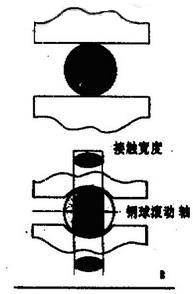Instead of an intermediate medium between the moving element and the fixed element of the linear guide, a rolling steel ball is used. Because the rolling steel ball is suitable for high-speed movement, small friction coefficient and high sensitivity, it can meet the working requirements of moving parts, such as tool holders and carriages of machine tools. The basic function of the fixed element (rail) of the linear guide system is like a bearing ring, a bracket for mounting a steel ball, and the shape is a "v" shape. The bracket wraps around the top and sides of the rail. In order to support the working parts of the machine tool, a set of linear guides has at least four brackets. Used to support large work pieces, the number of brackets can be more than four.
When the working part of the machine tool moves, the steel ball circulates in the groove of the bracket, and the wear amount of the bracket is distributed to each steel ball, thereby extending the service life of the linear guide. In order to eliminate the gap between the bracket and the guide rail, the preloading can improve the stability of the rail system and obtain the preload. An oversized steel ball is placed between the rail and the bracket. The diameter tolerance of the steel ball is ±20 μm. In the increment of 0.5 μm, the steel balls are sorted and classified into the guide rails. The magnitude of the preload is determined by the force acting on the steel ball. If the force acting on the steel ball is too large, the steel ball is subjected to the preloading time for too long, resulting in an increase in the kinematic resistance of the bracket. There is a problem of balance here; in order to improve the sensitivity of the system and reduce the resistance to motion, the preload is reduced accordingly, and in order to improve the accuracy of motion and the accuracy, it is required to have sufficient pre-added negative numbers. aspect.
When the working time is too long, the steel ball begins to wear, and the preload applied to the steel ball begins to weaken, resulting in a decrease in the movement accuracy of the working parts of the machine tool. If you want to maintain the initial accuracy, you must replace the rail brackets or even replace the rails. If the rail system is preloaded. The system accuracy has been lost, the only way is to replace the rolling elements.
The design of the rail system strives to maximize the contact area between the fixed component and the moving component. This not only improves the load carrying capacity of the system, but also the system can withstand the impact force generated by intermittent cutting or gravity cutting, spreading the force widely and expanding the bearing capacity. The area of ​​force. In order to achieve this, the shape of the groove of the guide rail system is various, and there are two representative ones, one is called the Gothic type (the pointed arch type), the shape is the extension of the half-circle, and the contact point is the apex; One is a circular arc that can also perform the same function. No matter which type of structure, there is only one purpose, and strive to contact more of the radius of the rolling steel ball with the guide rail (fixed component). The factor that determines the performance characteristics of the system is how the rolling elements come into contact with the rails, which is the key to the problem.

image 3
Linear roller guide
The linear roller guide system is a combination of a flat guide rail and a linear roller guide rail. The roller is mounted on the parallel guide rail, and the roller is used to carry the moving parts of the machine. The utility model has the advantages of large contact area, large carrying load and high sensitivity. From the tail of the bed, the bracket and the roller are placed on the top and side of the plane rail. In order to obtain high precision, a wedge plate is arranged between the working part of the machine tool and the inner surface of the bracket, so that the preload is applied to the side of the bracket. The working principle of the wedge plate is similar to that of the inclined iron, and the weight of the working part acts on the top surface of the bracket. Since the preload applied to the rail system is adjustable, the loss of the wedge is compensated for. This feature is widely used on medium or large machine tools because it is sensitive to CNC commands and bears large loads. The roller guide system can withstand high speeds and improve machine performance over conventional flat guides.
Previous page next page